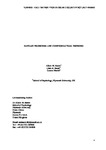Fantasy proneness and counterfactual thinking
| dc.contributor.author | Bacon, AM | |
| dc.contributor.author | Walsh, CR | |
| dc.contributor.author | Martin, L | |
| dc.date.accessioned | 2014-04-01T12:13:50Z | |
| dc.date.available | 2014-04-01T12:13:50Z | |
| dc.date.issued | 2013-03 | |
| dc.identifier.issn | 0191-8869 | |
| dc.identifier.uri | http://hdl.handle.net/10026.1/2929 | |
| dc.description.abstract |
Counterfactual thinking (CFT; mentally simulating alternatives to reality) is central to learning and motivation. Two studies explored the relationship between CFT and fantasy proneness, a personality trait typified by excessive fantasies hard to distinguish from reality. In study1, participants completed a fictional diary entry which was used to measure spontaneous CFT and the Creative Experiences Questionnaire measure of fantasy proneness. Fantasy proneness was significantly correlated with the generation of counterfactual thoughts. Both CFT and fantasy proneness have been independently associated with low mood and study2 included a measure of negative emotional state (the Depression, Anxiety and Stress scale) in addition to the CEQ and CFT. Fantasy proneness and negative emotion both predicted CFT, but no interaction between them was observed. The results suggest that individuals high in fantasy proneness have a general tendency to think counterfactually. © 2012 Elsevier Ltd. | |
| dc.format.extent | 469-473 | |
| dc.language | en | |
| dc.language.iso | en | |
| dc.publisher | Elsevier BV | |
| dc.subject | Counterfactual thinking | |
| dc.subject | Fantasy proneness | |
| dc.subject | CEQ | |
| dc.subject | Mood | |
| dc.subject | DASS | |
| dc.title | Fantasy proneness and counterfactual thinking | |
| dc.type | journal-article | |
| dc.type | Article | |
| plymouth.author-url | https://www.webofscience.com/api/gateway?GWVersion=2&SrcApp=PARTNER_APP&SrcAuth=LinksAMR&KeyUT=WOS:000314434800002&DestLinkType=FullRecord&DestApp=ALL_WOS&UsrCustomerID=11bb513d99f797142bcfeffcc58ea008 | |
| plymouth.issue | 4 | |
| plymouth.volume | 54 | |
| plymouth.publication-status | Published | |
| plymouth.journal | Personality and Individual Differences | |
| dc.identifier.doi | 10.1016/j.paid.2012.09.023 | |
| plymouth.organisational-group | /Plymouth | |
| plymouth.organisational-group | /Plymouth/Faculty of Health | |
| plymouth.organisational-group | /Plymouth/Faculty of Health/School of Psychology | |
| plymouth.organisational-group | /Plymouth/REF 2021 Researchers by UoA | |
| plymouth.organisational-group | /Plymouth/REF 2021 Researchers by UoA/UoA04 Psychology, Psychiatry and Neuroscience | |
| plymouth.organisational-group | /Plymouth/REF 2021 Researchers by UoA/UoA04 Psychology, Psychiatry and Neuroscience/UoA04 REF peer reviewers | |
| plymouth.organisational-group | /Plymouth/Research Groups | |
| plymouth.organisational-group | /Plymouth/Research Groups/Centre for Brain, Cognition and Behaviour (CBCB) | |
| plymouth.organisational-group | /Plymouth/Research Groups/Centre for Brain, Cognition and Behaviour (CBCB)/Behaviour | |
| plymouth.organisational-group | /Plymouth/Research Groups/Centre for Brain, Cognition and Behaviour (CBCB)/Cognition | |
| plymouth.organisational-group | /Plymouth/Research Groups/Plymouth Institute of Health and Care Research (PIHR) | |
| plymouth.organisational-group | /Plymouth/Users by role | |
| plymouth.organisational-group | /Plymouth/Users by role/Academics | |
| dc.rights.embargoperiod | Not known | |
| rioxxterms.versionofrecord | 10.1016/j.paid.2012.09.023 | |
| rioxxterms.licenseref.uri | http://www.rioxx.net/licenses/all-rights-reserved | |
| rioxxterms.type | Journal Article/Review |


